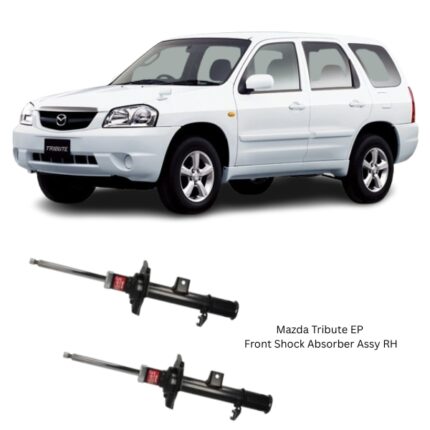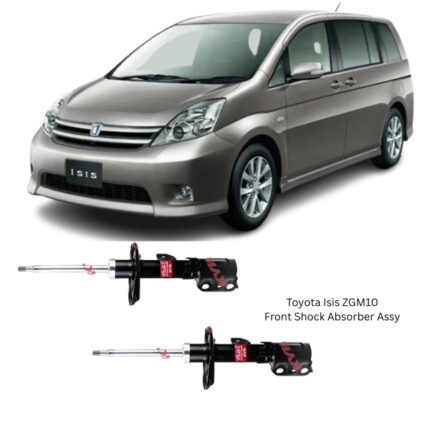-17%
Get Toyota Isis ZGM10 Front Shock Absorber Assy 339340 in Kenya
The Front Shock Absorber Assembly is one of the most crucial elements in a vehicle’s suspension system, designed to provide stability, comfort, and control by regulating the movement of the front wheels. Positioned between the chassis and suspension, it plays a pivotal role in absorbing road shocks, managing suspension oscillations, and ensuring optimal contact between the tires and the road surface.
Without a properly functioning front shock absorber assembly, driving becomes uncomfortable, unstable, and potentially unsafe, especially under conditions like braking, cornering, or driving over uneven surfaces. This component is engineered to meet the demands of daily driving while also supporting more intense road conditions.
Primary Purpose and Function
At its core, the front shock absorber assembly is a hydraulic or gas-filled unit that resists unwanted suspension motion by converting kinetic energy into heat, which is then dissipated through fluid or gas. It ensures that the up-and-down motion of the front wheels is dampened and controlled. Key functions include:
-
Dampening Suspension Movement: The assembly smooths out bumps and vibrations by absorbing energy from the springs and dissipating it gradually.
-
Maintaining Wheel Contact: It ensures that the front tires remain in contact with the road for consistent steering, traction, and braking performance.
-
Controlling Body Motion: Reduces pitch during acceleration and deceleration, and minimizes roll during cornering.
-
Improving Ride Comfort: By reducing the effect of uneven terrain, it makes driving more comfortable for passengers and the driver.
Construction and Materials
The front shock absorber assembly is a sealed, precision-engineered component built to withstand extreme pressures and temperatures. Its design integrates several key elements:
1. Outer Housing (Body)
This tubular metal structure serves as the shock’s exterior. It is often made from high-tensile steel or aluminum and is coated to resist corrosion, dirt, and moisture.
2. Piston and Rod
Housed within the shock body, the piston is attached to a hardened, chrome-plated rod that moves up and down through hydraulic fluid. The piston features tiny valves that allow fluid to pass through at a controlled rate, providing resistance and damping.
3. Hydraulic Fluid or Gas Charge
Inside the main chamber is hydraulic oil that flows through the piston valves during compression and rebound. In gas-charged designs, a nitrogen charge prevents aeration or foaming of the oil, which improves performance under aggressive or continuous use.
4. Valve System
The heart of the shock absorber, this set of precision-calibrated valves regulates the speed at which fluid moves. This directly affects how stiff or soft the shock is in different situations.
5. Seal and Guide Bushings
These are designed to keep the fluid inside the unit while preventing contaminants such as dust, dirt, and water from entering. High-quality seals ensure long-term reliability.
6. Mounting Points
The assembly comes with upper and lower mountings — bushings or eyes — that attach to the vehicle’s frame and suspension arm. These are often integrated with rubber or polyurethane to absorb vibration and reduce noise.
Types of Front Shock Absorber Assemblies
Several types of front shock absorber assemblies are available, each designed to suit specific vehicle dynamics and driver preferences:
-
Twin-Tube Hydraulic: Basic configuration using two concentric cylinders for damping. Provides adequate performance for general road use.
-
Twin-Tube Gas-Charged: Similar to the hydraulic type, but with nitrogen gas pressurization to reduce fluid aeration and improve response.
-
Monotube Design: Features a single large cylinder with separate gas and fluid chambers. Offers better heat dissipation and faster response.
-
Coilover Assembly: Incorporates a coil spring around the shock body, typically adjustable in terms of ride height and damping rate. Ideal for performance or load-sensitive applications.
-
Electronic Adaptive Shocks: Advanced systems capable of changing stiffness in real-time, depending on road and driving conditions.
Performance Characteristics
A well-designed front shock absorber assembly offers a balanced combination of damping force, structural strength, and thermal performance. Key attributes include:
-
Responsive Damping: Quickly adapts to road variations for improved handling and comfort.
-
Temperature Resistance: Built to maintain consistent performance across a wide range of operating temperatures.
-
Long Cycle Life: Engineered to sustain thousands of compression-rebound cycles with minimal wear or loss in efficiency.
-
Noise and Vibration Reduction: Isolates minor road vibrations and prevents transmission to the cabin.
Installation Considerations
The front shock absorber assembly is usually mounted vertically between the lower control arm or knuckle and the strut tower or chassis. Installation often requires:
-
Lifting the vehicle safely
-
Removing the front wheel
-
Unbolting the old shock from its mounting points
-
Replacing with the new assembly, ensuring proper torque specifications are followed
Replacing shocks in pairs (left and right) is highly recommended to preserve ride balance and symmetrical performance.
Signs of Wear or Failure
Like any suspension component, the front shock absorber assembly is subject to wear over time. Indicators of failure include:
-
Excessive bouncing or nose-diving when braking
-
Visible oil leakage around the shock body
-
Clunking or rattling sounds when driving over bumps
-
Uneven tire wear
-
Increased stopping distance
-
Poor steering response or body roll during turns
Periodic inspection of the shock absorber should be part of a standard maintenance schedule, typically every 40,000 to 100,000 kilometers, depending on usage and road conditions.
Safety and Driving Impact
The front shock absorber assembly is essential to a vehicle’s safety profile. When operating at optimal levels, it improves:
-
Steering Precision: Offers direct feedback and stable handling during cornering or sudden maneuvers.
-
Braking Control: Maintains tire contact, especially during emergency stops.
-
Load Balance: Minimizes weight transfer that can affect suspension geometry or stability.
-
Cabin Isolation: Reduces road harshness, enhancing long-distance driving comfort and fatigue reduction.
A worn shock absorber not only compromises performance but also increases stress on other components like springs, tires, and bushings.
Material Quality and Durability
Top-tier front shock absorber assemblies are constructed using:
-
High-strength steel or aircraft-grade aluminum for the cylinder
-
Chrome-plated piston rods for corrosion and wear resistance
-
Multilayer piston seals for leak-proof reliability
-
Precision-machined valves for exact fluid control
These materials and processes ensure long operational life, even under challenging driving conditions like off-road use or heavy traffic.
Follow us on Facebook for more parts.




